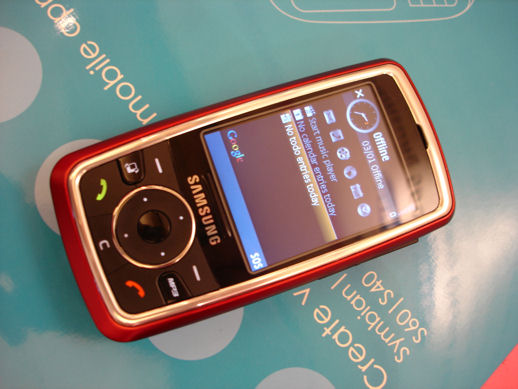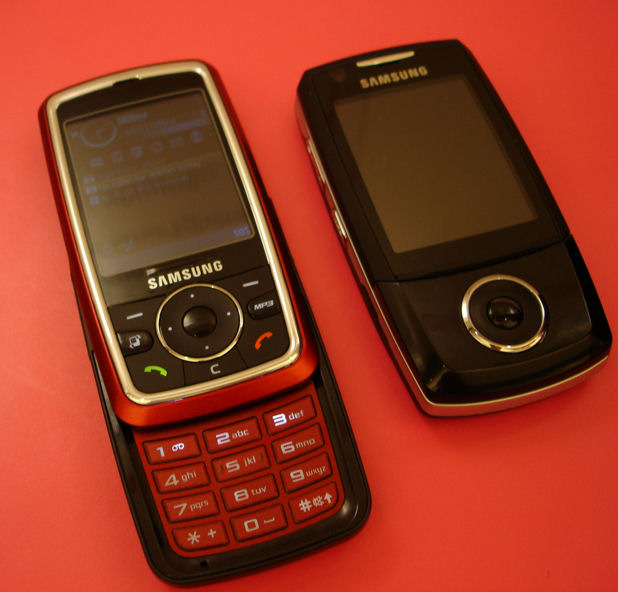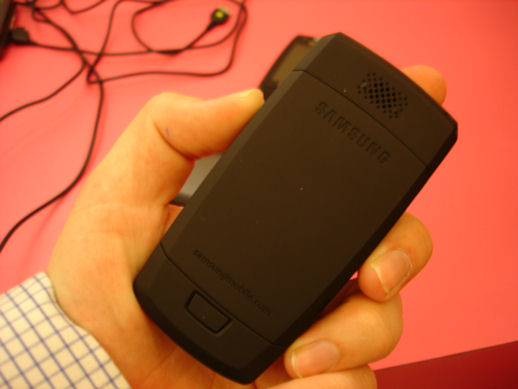5 minutes with the Samsung SGH-i400
The Samsung SGH-i400 received its debut at the S60 Summit last week (April 2007). It is the second S60 3rd Edition Feature Pack 1 phone from Samsung. The i400 is a triband EDGE device with a 2.3 inch QVGA screen, a 2 megapixel camera, microSD card slot, Bluetooth 2.0 (including A2DP) and USB 2.0. At a size of 101x50x15.8 mm and a weight of 92g it is one of the smallest S60 devices available thus far and comfortably the thinnest slider. Samsung's expertise in creating slide form factor devices really shines through and overall the i400 is an attractive device.
The i400 has a standard set of keys including the familiar round Samsung directional control. This is a proven key control and is comfortable to use for navigating the UI, although it may be less suitable for gaming. The main keypad, on the lower part of the slide, is reasonable, although the generous spacing between the keys means experienced T9 users should be able to achieve high text entry speeds. There are volume controls and a power button on the left side of the device. There is no pencil key, instead the hash key is used to duplicate the functions previously assigned to the pencil key (such as multiple selection in lists).

The Samsung SGH-i400. Further Pictures are available in our S60 Summit Gallery.
The i400 is a lower cost alternative to its sibling device, the Samsung SGH-i520. The differing cellular radios are the only real hardware difference and the removal of the 3G capabilities will reduce costs both in hardware and intellectual property royalties. The phones are based on Texas Instrument's OMAP 2430 platform, which although less graphically capable than the OMAP 2420 (used in the N93 and N95), is a powerful chip and as a result the S60 interface is extremely speedy.
The images produced by the i400's 2 megapixel camera seem reasonable, but there's no auto-focus. There is a camera capture key on the side of the device (just below the memory card slot) and the camera was responsive and processed the images quickly. The music capabilities are more promising, with stereo speakers, support for multiple audio formats and support for large memory cards. There is a dedicated MP3 button on the front of the phone that takes you directly into the Music Player application. The familiar S60 3rd Edition applications are all present, with the Web browser being a standout feature that was keenly promoted by Samsung.
The i400 has a few hardware features that are worth paying attention to. The USB connection, although it uses a proprietary connector, does support charging via USB. The microSD card slot supports sizes up to 4GB which means it supports the newer SDHC format. The i400 is expected to become available in Q3 and is likely to have broad appeal and will be sold in both Eastern Europe and in other emerging markets. The i400 may also be made available in more mature markets as a lower cost alternative to the i520.
Samsung's S60 Commitment
Previous Samsung S60 phones, such as the D720 and D730, have only been sold in limited markets and in small numbers. However, when Samsung previewed the SGH-i520 (the 3G brother of the SGH-i400) at the Symbian Smartphone Show, Samsung spokespeople said that it marked a change in strategy for Samsung away from individual devices and towards families of devices. The message, played up by S60, was that Samsung was committed to producing a range of S60 phones. This was reaffirmed at 3GSM when Vodafone, S60 and Samsung showed off a Vodafone branded SGH-i520 as part of the fruition of Vodafone's 3GSM 2006 (one year earlier) announcement of S60 as one of its preferred platforms.
In talking with Samsung representatives at the S60 Summit, it became clear that we can expect further Samsung S60 devices later in the year and beyond. Samsung will be waging the megapixel war in the camera department and there will be different form factors used in future products. As with the i520 and i400 combination, a mix of both high end and mid tier devices will be bought to the market. The previous Samsung S60 models were largely produced as individual projects by one group from end to end. With the i520, i400 and future products, this has changed - the underlying family device (i.e. a base built on Symbian 9.2 and S60 3rd Edition Feature Pack 1) has been produced by a research and development group based in the UK, but this will be taken to market as a number of different products (the first of which are the i520 and i400) by a number of product groups (based in Korea).

The Samsung SGH-i400 (left) and Samsung SGH-i520 (right)
This will both increase the number of products being produced, reduce the time to market and significantly reduce costs for Samsung. It is the fulfillment of the platform promise that Nokia has used to great advantage for its own devices over the last two years. Samsung will release a number of further products based on the S60 3rd Edition Feature Pack 1 family of devices. It is already working on a Symbian 9.3/S60 3rd Edition Feature Pack 2 family in the research and development group and we can expect to see the first of these devices in 2008.
All of this is very good news for everyone in the S60 ecosystem. Although the majority of devices will continue to be produced by Nokia for the foreseeable future it is encouraging to see a strong commitment from Samsung. The presence of Samsung will help drive competition and innovation and will be especially welcomed by third party software vendors. It also helps legitimize S60 as a platform and, by giving operators more options, should make them less nervous. How successful the Samsung devices will be is open to debate, but with one large operator already on board the initial signs are promising. Whether other manufacturers can be attracted to S60 is less clear.
Samsung's interest in S60 is likely to be partly driven by S60's links and agreements with operators such as Vodafone, Telefonica, Orange and others. There are now as many as 8 large operators working with S60 to create their own customised version (branded and with specific applications) of the S60 platform. Samsung has drawn a great deal of its success from working closely with operators, and with an ever increasing number of operators making significant commitments to various software platforms it makes good business sense to explore this area. Moreover with the advent of single chip solutions, reduced hardware requirements and falling component prices, the bill of materials (the cost to make the phone) has been significantly reduced and the mid tier market, with its larger volumes, is now accessible to S60 devices.
The Samsung SGH-i520
Samsung announced the SGH-i520 at the Symbian Smartphone Show and gave it a world premier at 3GSM. At the S60 Summit it was indicated that the i520 had started shipping in select European markets. The i520 is a 3G device with support for HSDPA, a 2 megapixel camera, 2.3 inch QVGA screen, Bluetooth 2.0, 45MB of internal flash memory and a microSD card slot. It is targeted as a high end multimedia phone (supports WMA, MP3, AAC, WMV, MP4 with H.263 and H.264) with an emphasis on the ability to download video and other media at high speeds. Outside of Samsung hardware design and feel, there are few differences between it and Nokia's S60 devices. There are a few cosmetic changes to the software, such as the inclusion of a Google search box on the Active Idle screen and a theme to match the look of other Samsung devices.

The new backing material on the i520
The Vodafone branded SGH-i520 will go on sale in various European markets very shortly (the support pages are now available on the Vodafone web site) and a non-operator branded variant is expected to be available shortly afterwards. The Vodafone version includes some Vodafone specific applications, together with the expected branding and renaming of existing applications and screens. There has been one significant design change from the prototype devices. The material used in the battery cover and backing has been changed from a slippery plastic to a more grippy hard rubberized material and it is a very welcome change. The touch sensitive buttons remain, and I remain unconvinced by these, but a significant improvement is that the sensitivity of these buttons can now be adjusted in the settings software. We will take a closer look at the Samsung SGH-i520 in due course.
Rafe Blandford, AllAboutSymbian, 30 April 2007
